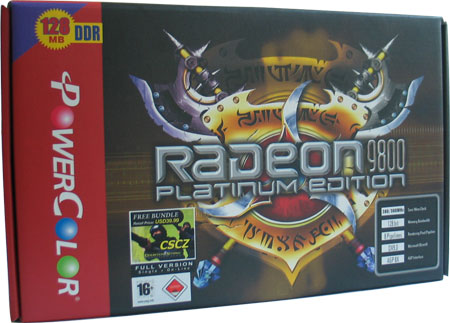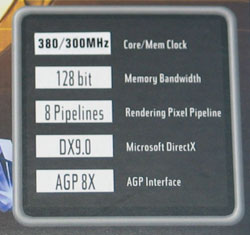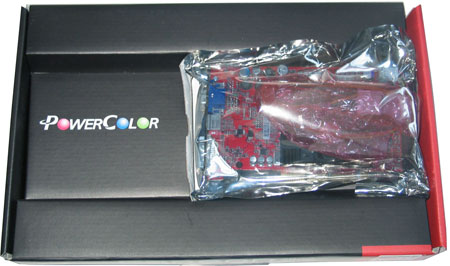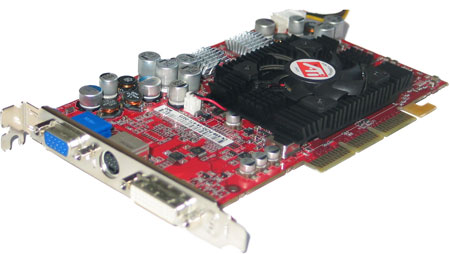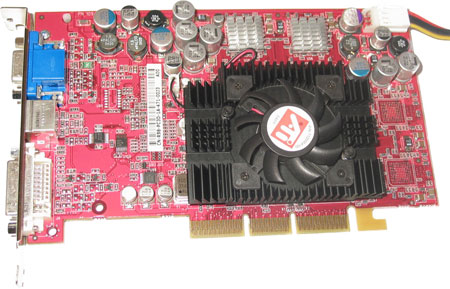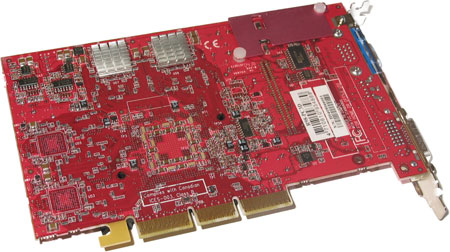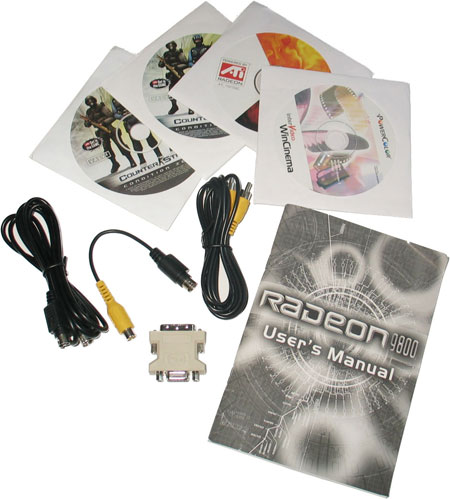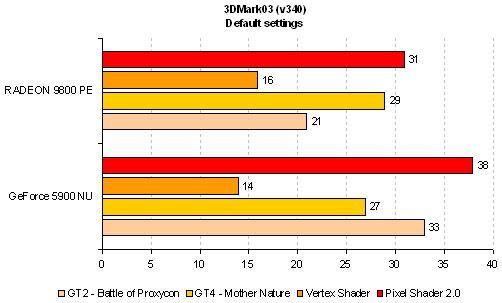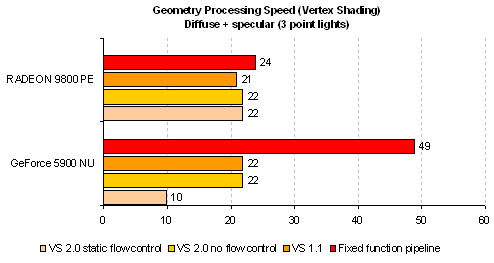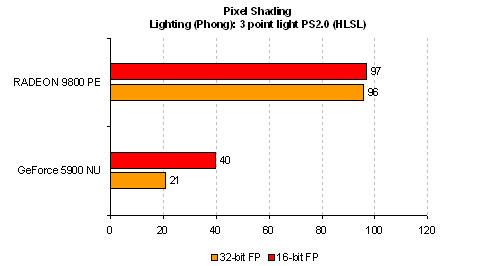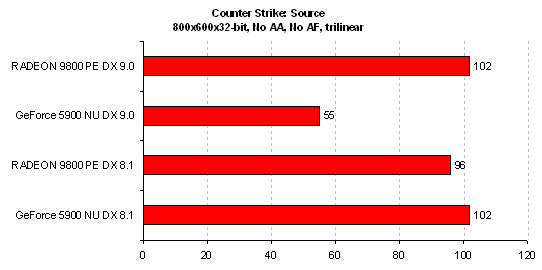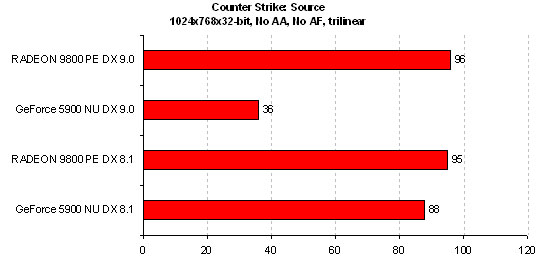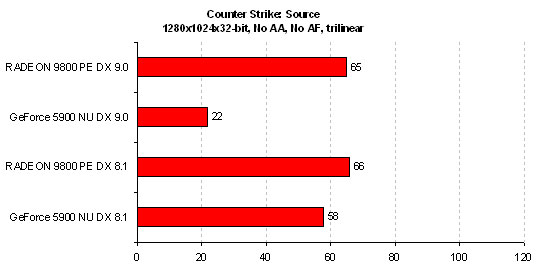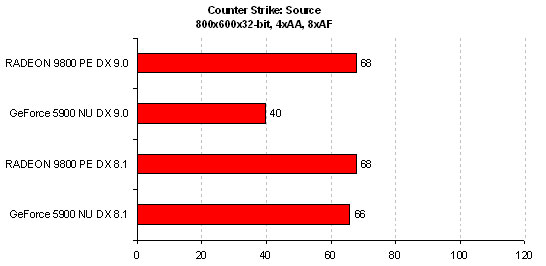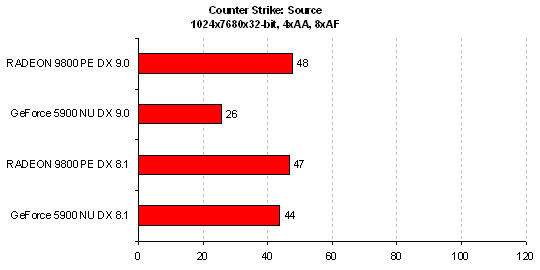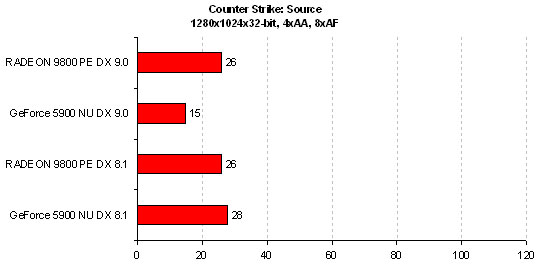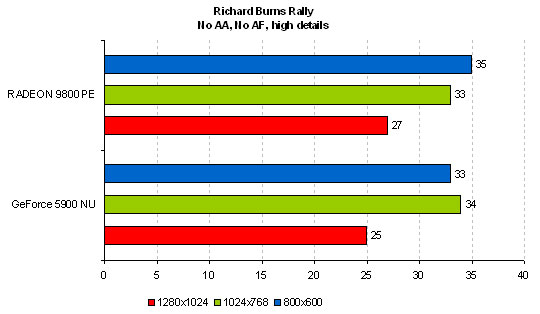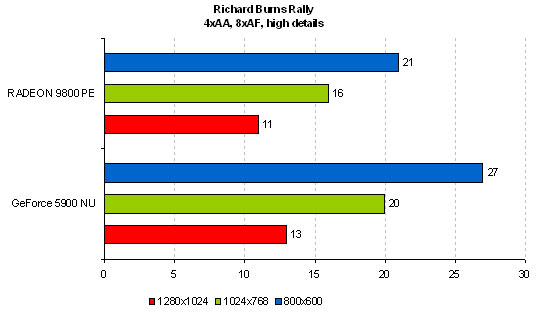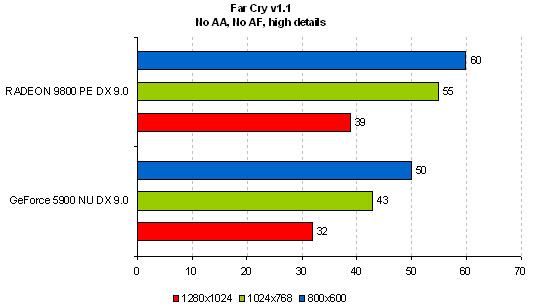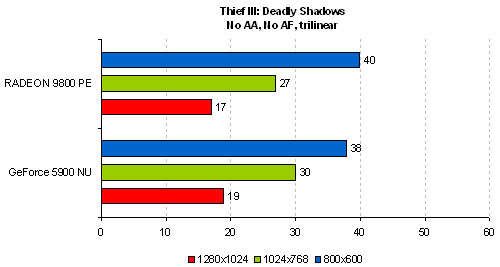Maybe this isn’t a top of the line video card but for around $160 you get a very decent performance and a cool multiplayer game which retails at $39.99. As to memory architecture confusions, I think the box was appropriately labled as a 128-bit version. Looking back at some of the benchmarks, it’s pretty clear that this card can push a lot of pixels even with 9.6 GB’s of memory bandwidth and a slower clocked memory.
Introduction
Today we are looking at the PowerColor RADEON 9800 Platinum Edition. For those that don’t know, Tul owns the PowerColor brand and is the third largest provider of ATI-based graphic cards. The company makes very competitive products that are known all over the world. Although the RADEON 9800 has been around for some time now, this card is something totally different — and I do mean it.
If you remember, back in May Sapphire introduced a weird card based on the R350 core. The introduction of the 128-bit 9800 Pro created a lot of confusion in the market. The main problem was the company sold the card as a regular 9800 Pro, when in fact it was not. Although there was a little sticker informing the customer about the 128-bit memory architecture, the card’s name was very misleading. The problem was addressed and official response from Sapphire can be found here.
The PowerColor RADEON 9800 Platinum Edition is similar to what Sapphire introduced few months ago. I could only assume those cards were introduced because there was a strong need to get rid of older chips and make room for the R420-based cards. Whether this is true or not, products like these should be labeled correctly without misleading potential customers. I’d like to point out again, that this is not a high-end RADEON 9800.
Despite the stated facts, PowerColor’s offering is pretty interesting that’s why we took some time and looked what’s under the hood.
VPU Specifications
The technical specifications of PowerColor’s RADEON 9800 PE aren’t that far of from the other RADEON 9800’s. However the biggest difference is the memory architecture and memory clocks.
| PowerColor |
RADEON 9800 Platinum Edition |
| VPU (256-bit) |
R360
|
| Chip Architecture |
.15µ Process
|
| Transistors |
~110 Million
|
| Memory Architecture |
128-bit / up to 256MB of DDR I RAM (BGA)
|
| Pipeline Architecture |
8×1
|
| Bus Type |
AGP 4X, 8X
|
| Core Clock |
380 MHz
|
| Memory Clock |
300 MHz (600 MHz DDR)
|
| RAMDAC’s |
Dual 10-bit per channel 400 MHz DACs
|
| Memory Bandwidth |
9.6 GB / sec
|
| Pixel Fillrate |
3.0 GPixels / sec
|
| Texel Fillrate |
3.0 GTexels / sec |
The name “Platinum Edition” is a bit misleading here (As with Sapphire’s Atlantis 9800 Pro). Looking at the above chart, the card is based on the R360 ASIC with a PCB similar to that of a RADEON 9700 and RADEON 9500 Pro, however memory architecture is not what you would normally expect from the R360-based board. It sports a 128-bit interface combined with 600 MHz DDR RAM. That gives us only 9.6 GB of memory bandwidth a second. This isn’t much, considering 256-bit RADEON 9800 Pro clocked at 680 MHz DDR pushes roughly 22 GB of RAW bandwidth a second. Unlike Sapphire’s offering, PowerColor RADEON 9800 PE uses BGA memory chips which is a good thing.
- Eight parallel rendering pipelines
- Four parallel geometry engines
- 128-bit DDR memory interface
- AGP 8X support
- SMARTSHADER 2.1
- Full support for Microsoft® DirectX® 9.0 programmable vertex and pixel shaders in hardware
- 2.0 Vertex Shaders support vertex programs up to 65,280 instructions with flow control
- 2.0 Pixel Shaders support up to 16 textures per rendering pass
- New F-buffer technology supports pixel shader programs with unlimited instructions
- 128-bit, 64-bit & 32-bit per pixel floating point color formats
- Multiple Render Target (MRT) support
- Shadow volume rendering acceleration
- Complete feature set also supported in OpenGL® via extensions
- SMOOTHVISION 2.1
- 2x/4x/6x full scene anti-aliasing modes
- Adaptive algorithm with programmable sample patterns
- 2x/4x/8x/16x anisotropic filtering modes
- Adaptive algorithm with bi-linear (performance) and tri-linear (quality) options
- HYPER Z III+
- 3-level Hierarchical Z-Buffer with early Z test
- Lossless Z-Buffer compression (up to 24:1)
- Fast Z-Buffer Clear
- Z cache optimized for real-time shadow rendering
- TRUFORM 2.0
- 2nd generation N-Patch higher order surface support
- Discrete and continuous tessellation levels per polygon
- Displacement mapping
- VIDEOSHADER
- Seamless integration of pixel shaders with video
- FULLSTREAM video de-blocking technology
- Noise removal filtering for captured video
- MPEG-2 decoding with motion compensation, iDCT and color space conversion
- All-format DTV/HDTV decoding
- YPrPb component output
- Adaptive de-interlacing and frame rate conversion
- Dual integrated display controllers
- Integrated 165 MHz TMDS transmitter (DVI 1.0 compliant and HDCP ready)
- Integrated TV Output support up to 1024×768 resolution
- Windows® Logo Program compliant
This is the same feature-set as with regular 256-bit RADEON 9800’s. The 9800 PE is still a two pixel-quad design meaning it is capable of rendering 8 pixels per clock cycle with 1 texture applied to a pixel (An 8×1 design where each pipeline has 1 TMU).
The Card
As I’ve mentioned before, the PCB design of PowerColor 9800 Platinum Edition is no different than that of RADEON 9500 Pro / 9700. The card sports 128 MB’s of DDR I RAM clocked at 300 MHz (600 MHz effective) which is a tad slower compared to regular RADEON 9800. The core clock is rated at 380 MHz.
When looking at the box, you’ll notice an information sticker which tells you three most important features of the card: core / memory clock rates, memory and pixel pipeline architectures.
On the upper left side of the box there is another sticker which tells you how much RAM the card has. Depending on the version you it will either read 128 MB or 256 MB. Although the information maybe flimsy to most, some less knowledged customers will definitely appreciate it.
The inside of the box is neat. It contains two upper chambers as well as the bottom where all bundle is stored. As you can see the card is packed inside a standard antistatic bag which also contains a 4-pin power cable.
Looking at the card itself, this is a standard ATI-based board. However memory chips have nice aluminum heatsinks. On the backplate you’ll find basic contectors (from the top): VGA 15-pin, S-Video, DVI
From the above picture you can see basic ATI heatsink+cooler setup which can be found on most ATI mainstream boards today.
The back of the card sports RAM heatsinks as well as anodized aluminum plate which cools parts that can get pretty hot.
BGA memory chips covered with RAM sinks (top and bottom).
In a nutshell, all you get is a plain looking card with RAM heatsinks. Nothing special about the design, but ATI-based boards have been that way since the beginning — no fancy cooling or various PCB colors as seen on some NVIDIA-based cards.
Bundle
The bundle inside RADEON 9800 PE is pretty standard. PowerColor decided to give you a free game, Counter-Strike: Condition Zero and WinCinema (a DVD software). Additionally there is a driver CD with CATALYST 3.8 suite. Pretty old considering the newest is 4.9
Besides the included software you get bunch of cables and a manual as seen from the above picture. S-Video cable, RCA to Composite cable and Composite RCA cable itself. Also a DVI to VGA connector has been included. The mentioned manual is written in five different languages: English, German, French, Spanish and Traditional Character Chinese. The inside instructions are clear and easy to follow for someone who isn’t too knowledged with computer hardware.
Let’s move on and see how the card’s installation went.
Setup and Installation
Below you will find complete system configuration as well as benchmarks used in this review.
|
Test system specifications
|
| ABIT NF7-S motherboard — nForce 4.24 drivers Chaintech 420 Watt PSU Athlon Barton XP 2800+ at 2100MHz 768 MBs of Corsair XMMS 3200 LLP RAM Windows XP SP2 DirectX 9.0c |
| PowerColor RADEON 9800 Platinum Edition — CATALYST 4.9 video driver PixelView GeForce FX 5900 NU — Forceware 61.77 video driver |
|
Benchmarks
|
|
Synthetic benchamrks: 3DMark 2001 SE (build 330) — default settings |
|
Game benchmarks: Counter-Strike: Source (custom demo + FRAPS) |
At the time of writing the review, ATI has released a new set of CATALYST video drivers which were used throughout the article. I divided benchmarks into two types: synthetic and game benchmarks. There are three resolution modes I’ve chosen for this review: 800×600, 1024×768 and 1280×1024. I left out 1600×1200 because the tested cards perform really as mainstream boards with my choice of DirectX 9 titles. Although you won’t find a huge game list in this review, I tried to concentrate on DirectX 9 performance for the most part.
This is really a typical hardawre installation procedure. Upon popping in the PowerColor RADEON 9800 PE I first uninstalled the Forceware drivers and used DriverCleaner to delete any files that were left. After that I was ready to put the card in. I haven’t had any trouble fitting the board inside since it’s much shorter than the FX 5900 NU. The card was recognized and it was the time to install CATALYST drivers. The whole driver suite (drivers + CATALYST Control Center) weighs a hefty 42.3 MB’s plus .NET Framework 1.1 which is around 23 MB’s. Those on dialup will probably want to install the old control panel which isn’t so bad in my opinion. The new one looks too candyish, is slow and eats up a lot of CPU cycles.
Let’s begin shall we?
3DMark 2001 SE
Let’s compare theoretical results with 3DMark’s benchmark results. I will be using 3DMark 2001 SE (build 330) for calculating theoretical measures.
| GPU |
RADEON 9800 PE |
GeForce FX 5900 NU |
| Pixel Fillrate |
926 MPixels / sec |
1.33 GPixels / sec |
| Texel Fillrate | 2.67 GTexels / sec |
2.62 GTexels / sec |
| Polygon Count (1 light) | 70 MTriangles / sec |
72 MTriangles |
| Polygon Count (8 light) | 17 MTriangles / sec |
21 MTriangles |
| Vertex Shader |
156 FPS |
141 FPS |
| Pixel Shader |
202 FPS |
165 FPS |
| Advanced Pixel Shader |
139 FPS |
98 FPS |
Although theoretical Pixel Fillrate of the PowerColor RADEON 9800 PE is 3.0 GPixels / sec, 3DMark gave us only 926 MPixels / sec — a pretty large difference. Texel Fillrate is a bit closer to the actual 3.0 GTexels / sec. Polygon Count tests report similar rates to that of a GeForce 5900 NU, though NV35 pushes more triangles with 8 lights than 9800 PE. Looking at PS / VS results, our RADEON does a bit better especially in pixel shading tests.
3DMark 2003
In Frames Per Second (higher is better)
In order to get a better look at the performance figures, I ran four more tests using 3DMark 2003 (build 340): GT2 – Battle of Proxycon, GT4 – Mother Nature, Vertex and Pixel Shader 2.0. In all those tests we are pretty much stressing the card’s Pixel Pipeline. Pixel Shader 2.0 and GT2 tests belong to the FX 5900 NU the other benchmarks are very in line. In GT4 RADEON scores 29 FPS, and 16 FPS for VS test.
D3D RightMark
D3D RightMark is a very useful tool for measuring different theoretical throughputs of a graphic card. I ran couple of synthetic tests to stress the RADEON 9800 PE and compare it with the GeForce 5900 NU.
With D3D RightMark you will be able to get the following information about your video card:
- Features supported by your video card
- Pixel Fillrate and Texel Fillrate
- Pixel shader processing speed (all shader models)
- Vertex shader (geometry) processing speed (all shader models)
- Point sprites drawing speed
- HSR efficency
In Frames Per Second (higher is better)
In this test, we are looking at the vertex shader’s (geometry) processing speed. I chose Diffuse + specular (3 point lights) for our lightning profile. This will give us peak geometrical throughput. In order to get a clearer overlook, four different shader profiles were used: Fixed Function Pipeline (FFP) VS 2.0 static flow, VS 2.0 no flowcontrol and VS 2.0 static flowcontrol. Our PowerColor 9800 PE does very well in all four tests getting similar scores for all shader profiles. GeForce 5900 NU in FFP (a basic T&L pipeline) mode does exceptionally well, but standard Transform & Lightning was always NVIDIA’s good side.
In Frames Per Second (higher is better)
Let’s have a look at the pixel shading performance. Lightning (Phong) PS 2.0 shading profile is a very good synthetic test that nicely stresses the pixel pipeline. You can choose all current Shader Models ranging from PS 1.1 all the way up to PS 3.0. In our case we are looking at Pixel Shader 2.0 and 16-bit / 32-bit floating point numbers. As expected, RADEON 9800 PE blows the FX 5900 NU out of the water scoring 97 and 96 FPS respectively.
Counter-Strike: Source
The saga continues. The popularity of this game should be beyond anyone’s expectations. Simply put it’s the most popular online game played today. For those not in the know, few weeks ago Valve invited all Counter-Strike: CZ owners as well as Half-Life 2 coupon holders to take part in Counter-Strike: Source open beta program. Note that after the beta ends, you will need to purchase Half-Life 2 or standalone CS:S.
So what’s the big deal you ask? Well, this version of Counter-Strike is based off Half-Life 2 Source engine which utilizes a very wide range of DirectX 8 / 9 special effects. Those include:
- Diffuse / specular bump mapping
- Dynamic soft shadows
- Localized / global valumetric fog
- Dynamic refraction
- High Level-of-Detail (LOD)
Unfortunately users with DirectX 7 and older hardware will not be able to enjoy the above effects. Here is another interesting bit: Source engine will default GeForce FX cards to DirectX 8.x path, even though it’s a DirectX 9 hardware.
Okay, so I fired up Counter-Strike: Source and obviously went into video options. Every setting was set to high and the default DirectX level was 9.0. When benchmarking FX 5900 NU Valve’s autodetection mechanism defaulted our API to DirectX 8.1 and set the water detail to simple reflections, however I did set it to reflect world (setting used when 9800 PE was detected).
I’ve decided to force DirectX 9 path on the GeForce FX 5900 NU in order to maintain apples-to-apples comparison against the reviewed RADEON 9800 PE. It’s not really cheating, but rather a helpful method of comparing similar cards. Note that forcing codepaths is not exposed in CS:S’s video options. Technically you could force any API path on NV3x and R3xx (ranging from DirectX 5.0 to DirectX 9.0) but it requires a console command mat_dxlevel example: mat_dxlevel 90. Also we’ve forced our RADEON 9800 PE to use the DirectX 8.1 codepath, a default codepath for FX 5900.
Now that we have explained our testing menthods a little, let’s take a look at the benchmarks
In Frames Per Second (higher is better)
Although this is only 800×600 resolution, you can clearly see difference in performance between the RADEON and the FX running DirectX 9 codepath. Almost a 100% difference. It’s a bit different story for DX 8.1 level though. GeForce outperforms the RADEON by a few FPS.
In Frames Per Second (higher is better)
Albeit our PowerColor RADEON 9800 PE sports a 128-bit memory bus, the GeForce doesn’t have the shader power to push those pixels — even when running DirectX 8.1 codepath.
In Frames Per Second (higher is better)
As seen from this example, the 9800 PE does really well at 1280×1024 (both DirectX 8.1 / 9.0 codepaths).
Let’s take a look at some benchmarks with Antialiasing and Anisotropic Filtering enabled.
In Frames Per Second (higher is better)
68 FPS is a very playable framerate, although not a lot of gamers would want to use this particular resolution. Forcing DX 8.1 codepath produces the exact same score for the RADEON. The GeForce keeps up with its competitor pretty well, though only when running in DirectX 8.1 mode.
In Frames Per Second (higher is better)
I think I’ve hit a sweet spot with this setting. An average of 48 frames per second under 1024×768 and 4xAA / 8xAF is a pretty good score considering I’m pretty much GPU limited. Running in DirectX 8.1 mode, both FX 5900 NU and RADEON 9800 PE demonstrate similar framerates.
In Frames Per Second (higher is better)
This is an example where memory bandwidth is crucial and 128-bit memory architecture just doesn’t cut it. Neither does FX’s 4×2 pipeline configuration. 26 FPS wasn’t really playable since I’ve been getting minimal framerates of 10.
Was Gabe Newell right when he said RADEON 9800’s were the only cards (back then of course since GeForce 6 boards run DirectX9 codepath flawlessly) able to run Half-Life 2 at high FPS? At that time he was right, although I didn’t really believe the 128-bit 9800 from PowerColor would do the trick. The playable framerates of the 9800 Platinum Edition did surprise me to say the least.
Richard Burns Rally
Last rally title I’ve played was RalliSport Challenge from Microsoft. A week or so ago, SCi Games released their highly anticipated Richard Burns Rally (another one coming up is Xpand Rally from Techland which also seems interesting). This is not an arcade game, it’s a pure rally simulation. You might also recon Colin McRae series, though lately Codemasters did not put enough effort into redesigning their CMR game engine.
Richard Burns Rally is a great car simulation with stunning environment, superior car models and most importantly physics. The game is very hard especially when you don’t have a wheel (SCi recommends Logitech® MOMO® Racing Wheel).
Looking at the requirements, you will need at least a DirectX 8 class hardware which supports pixel / vertex shading (hardware T&L will not do the trick). The game uses a lot of pixel and vertex shaders to achieve most of the in game effects.
In Frames Per Second (higher is better)
Unlike First Person Shooters, you will not need a constant of 50 FPS when playing a simulation or arcade type game. However framerates below 30 are not welcome either. I decided to benchmark in three resolutions, leaving 1600×1200 out of the game for an obvious reason: both cards used can be considered mainstream for this game title. At 800×600 our RADEON does pretty well scoring an average of 35 frames per second.
In Frames Per Second (higher is better)
Just to give you an idea what kind of performance you can get out of our PowerColor RADEON 9800 PE, I’ve decided to bench it with Antialiasing (x4) and Anisotropic Filtering (x8) enabled. The results were a bit disappointing, but it’s understandable considering the 9800 PE pushes a mere 9.6 GBs / sec. The FX 5900 NU does a bit better, but still not enough frames per second to consider 4xAA, 8xAF usable for this title.
Far Cry
The company behind this game is Crytek. It’s pretty much the first title which uses a heavy load of PS 2.0. We are using the full version with 1.1 patch applied (note that patch version 1.2 was withdrawn due to issues with R420 hardware). Anyone who played it will admire the draw distance, beautiful outside vegetation and incredibly spooky indoor environment. The game also features topnotch self-learning A.I and very realistic physics.
Far Cry’s CryEngine is pretty scalable, however you’d need at least DirectX 8 class hardware to enjoy the refractive water effects, real time per-pixel lighting, specular bump-mapping or volumetric effects.
In our case the game is GPU limited, but I’ve decided to bench the 9800 PE using high details. Same goes for the 5900 NU. This is yet another example where developer decides to default GeForce FX cards to DirectX 8.1 codepath. Again, for somewhat apples-to-apples comparison I needed to force DirectX 9 effects for the 5900 NU using the following parameter: d3d9_nv30_ps20 = “1”.
The map of choice was Research. It’s a high-polygon map with both outdoor and indoor environment.
In Frames Per Second (higher is better)
The PowerColor 9800 PE does an average of 55 (solid) FPS at 1024×768. I couldn’t really complain about performance at this particular resolution. The gameplay was smooth without major slowdowns. Things have changed once I switched to 1280×1024. I do not recommend this particular resolution since there were times where minimum FPS reached around 10. Comparing it to 5900 NU, the 9800 PE is a clear winner.
In Frames Per Second (higher is better)
I only recommend enabling Antialiasing and Anisotropic Filtering if you are okay with 800×600 resolution. Other than that it’s pointless since average frames per second did not exceed 29 at 1024×768 and 19 for 1280×1024. Again, the lack of bandwidth results in such low FPS scores.
Thief III: Deadly Shadows
This is another DirectX 9 title. The original Thief was pretty successful since this type of game genre did not exist. With the release of Deadly Shadows the most obvious thing you’ll notice is the graphics engine. Also do not forget improved A.I and HAVOK physics. In order to keep the gameplay intensive and moody, developers decided to implement stencil shadows. One positive thing is that stencil shadows can accurately shadow other objects (self-shadowing is done automatically). The pitfall to this technique is performance since it requires three full passes before whole scene can be rendered.
Thief III uses stencil shadows very widely. Since shadow volumes are created by the CPU, you’ll definitely want to equip yourself with a fast one. Let’s take a glimpse at some benchmark results (in game details were set to high).
In Frames Per Second (higher is better)
As I mentioned above, there is a great performance hit with stencil shadows and Thief III is all about them. Looking at the scores you may ask yourself is it really worth to play this game? The above are really worst case scenario results because I’ve chosen a very nasty spot to benchmark. There is just a lot going on: big fire place, bumpy walls / floor, dynamic shadows (all using pixel and vertex shading).
As with Richard Burns Rally, you definitely do not need high FPS to enjoy this particular game. Throughout the first level I was really pleased to see our PowerColor 9800 PE perform so well. 27 FPS at 1024×768 isn’t really representative of the entire game — again it’s the worst you will probably get with a similar system configuration. At 1280×1024 some spots in the game made the card crawl a bit, that’s why I did not include Antialiasing / Anisotropic Filtering results. You could always tweak your game settings and try higher resolution, but there isn’t a lot to fiddle around with anyway.
Overclocking and Conclusions
I was a bit dissatisfied when it came down to overclocking the PowerColor RADEON 9800 PE. Using W1zzard’s ATITool, I was able to find the highest stable core and memory clocks. Remember that double checking for artifacts is a crucial step when overclocking video cards. Albeit ATITool has the ability to scan for artifacts, I found out that it was not enough. A series of 3DMark 2003 GT4 – Mother Nature loops were performed to ensure no artifacts were present.
Within an hour, I was able to conclude that 415 MHz (core) and 330 MHz (memory) were the maximum stable overclocks for the PowerColor 9800 Platinum Edition. That’s 35 MHz for core and 30 MHz for memory. The gain was minimal however, in best case scenario there was an increase of 2-5 FPS at most.
Overall I was pretty satisfied with PowerColor RADEON 9800 Platinum Edition. Maybe this isn’t a top of the line video card but for around $160 you get a very decent performance and a cool multiplayer game which retails at $39.99. As to memory architecture confusions, I think the box was appropriately labled as a 128-bit version. Looking back at some of the benchmarks, it’s pretty clear that this card can push a lot of pixels even with 9.6 GB’s of memory bandwidth and a slower clocked memory.
Those of you looking for a cheap video card upgrade, PowerColor 9800 Platinum Edition is definitely a great product to consider. Especially if you don’t own a 3.0+ GHz CPU which would definitely make you GPU limited.
Pros:
+ Fast considering its 128-bit memory architecture
+ RAM heatsinks
+ Free multiplayer game
+ Considerably cheap
Cons:
– Underclocked memory
– Poor overclocking results
With 8 rendering pixel pipelines and standard RADEON 9800 core clock, our PowerColor RADEON 9800 PE gets the rating of 8.5 (Very Good) out of 10 and the Bjorn3D Seal of Approval.
 Bjorn3D.com Bjorn3d.com – Satisfying Your Daily Tech Cravings Since 1996
Bjorn3D.com Bjorn3d.com – Satisfying Your Daily Tech Cravings Since 1996
